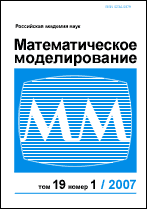|
This article is cited in 1 scientific paper (total in 1 paper)
Modification of the Wilson–Frankel kinetic model and atomistic simulation of the rate of melting/crystallization of metals
V. I. Mazhukin, A. V. Shapranov, O. N. Koroleva, A. V. Mazhukin
Keldysh Institute of Applied Mathematics of RAS
Abstract:
Within the framework of the kinetic-atomistic approach, a new approach is proposed for constructing the temperature dependence of the stationary velocity of propagation of the solid-liquid interface in metals: aluminum, copper and iron with different crystallographic orientations. The considered temperature range includes the range of maximum allowable overheating/overcooling values for each of the metals. A significant modification of the well-known kinetic model with the Wilson–Frenkel diffusion constraint, which is used to construct the response function, has been made. An atomistic simulation of the processes of melting/crystallization of metals aluminum, copper and iron was carried out over the entire temperature range using three interaction potentials of the "embded atom" family. By comparing the simulation results with the data of the modified kinetic model, the response function of the interface velocity in the range of maximum allowable overheating/overcooling values in metals is constructed using the least squares criterion. The use of the modified Wilson–Frenkel kinetic model in calculations significantly improves the accuracy of the response function over the considered temperature range. The resulting temperature dependence of the interface velocity is diffusion-limited and is described by the same equation for each metal over the considered temperature range.
Keywords:
kinetic model, atomistic modeling, solid–liquid interface, velocity of the interface, overheating/overcooling.
Received: 05.12.2022
Revised: 19.06.2023
Accepted: 03.07.2023
Citation:
V. I. Mazhukin, A. V. Shapranov, O. N. Koroleva, A. V. Mazhukin, “Modification of the Wilson–Frankel kinetic model and atomistic simulation of the rate of melting/crystallization of metals”, Matem. Mod., 35:11 (2023), 103–121; Math. Models Comput. Simul., 16:2 (2024), 223–234
Linking options:
https://www.mathnet.ru/eng/mm4508 https://www.mathnet.ru/eng/mm/v35/i11/p103
|

| Statistics & downloads: |
| Abstract page: | 149 | | Full-text PDF : | 9 | | References: | 27 | | First page: | 12 |
|




 Contact us:
Contact us: Terms of Use
Terms of Use
 Registration to the website
Registration to the website Logotypes
Logotypes







 Citation in format
Citation in format 
